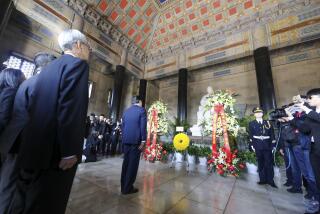Mao Tse-tung: A Long Decade Later
- Share via
It is 5 o’clock in Peking. The Chairman Mao Memorial Hall is closed. The pilgrims and tourists who have viewed Mao’s body lying in state--they average 50,000 a day--are gone. My students and I have been allowed in after-hours to photograph the white marble statue of Mao seated in the entrance hall, which seems to float against the tapestry of clouds and mountains behind him. Mao, though, had asked to be cremated. No grand tomb, no remains, just a place for his ashes.
As a young man, after a stint in the provincial militia, Mao considered becoming a policeman, a lawyer, a soap maker. For a time he taught elementary school. Even then he read Marx, and he began to graft onto this Western import of Marxism and Leninism his own distinctly Chinese perspective, which became known as Mao Tse-tung Thought, forever to be written with a capital T.
As a military leader, he held together a ragtag army and led them 6,000 grueling miles to escape the vastly superior Nationalist forces in the celebrated Long March of 1934-35. As a strategist, he directed his troops against the Japanese, and in 1949, after a civil war, he drove the ruling Nationalists under Chiang Kai-shek from the mainland.
But later, he was less adept at identifying enemies within, or coping with China’s primitive economic state. In 1958, his effort to catapult the country into economic vitality--known as the Great Leap Forward--was a debacle. And the chaotic 10 years from 1966 to 1976, the Cultural Revolution, turned intellectuals into pariahs, shattered private lives and public institutions and scarred a generation.
His errors were not his alone, and his contributions as founder of the party and the nation far outweighed his later mistakes, says China’s current leader, Deng Xiaoping. Deng has vowed that Mao’s portrait will forever hang in Tian An Men Square and that Mao Tse-tung Thought will be revered--though interpreted creatively.
Time has already transformed the image of Mao. In a flea market in Tianjin, the peddlers have added Mao buttons to their stock of treasures. Between 1966 and 1976, hundreds of millions of buttons were made, each with Mao’s profile painted in silver or gold against a blazing red sun. No one would wear them today--”people would think you were crazy,” laughs a former Red Guard--but no one dares throw them away, either. In Fuzhou, a city in southeast China straddling the Min River, a colossal statue of Mao faces a free market where peddlers and peasants haggle over the price of blue jeans, mirrored sunglasses and cassettes. At his back, at night, the strobe lights of a disco spin dizzily.
My students remember with precision the day Mao died. But in China, assaults on the present often begin with attacks on the past, and retrospectives are a sensitive undertaking. My students shy away from writing about Mao’s place in history. They say they would have to consult the Party’s documents to know the “correct position.” Some speak of a formula for weighing the good and the bad that Mao did: 70% good, 30% bad. Others shudder at separating him into fractions. We agree to restrict ourselves to the present.
This week, across the vast land, there will be public observances, and many will come here to pay their respects and to remember him. But the true measure of Chairman Mao will be taken in silence, in the privacy of a billion hearts.
More to Read
Sign up for Essential California
The most important California stories and recommendations in your inbox every morning.
You may occasionally receive promotional content from the Los Angeles Times.












